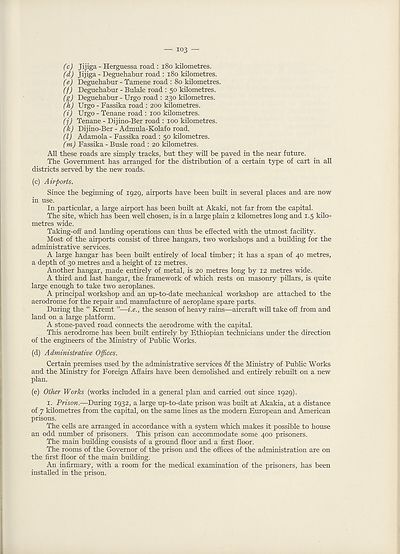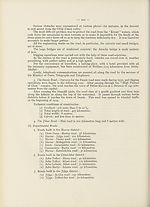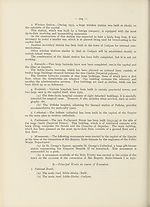Download files
Complete book:
Individual page:
Thumbnail gallery: Grid view | List view

— 103 —
(c) Jijiga - Herguessa road : 180 kilometres.
(d) Jijiga - Deguehabur road : 180 kilometres.
(e) Deguehabur - Tamene road : 80 kilometres.
(f) Deguehabur - Bulale road : 50 kilometres.
(g) Deguehabur - Urgo road : 230 kilometres.
(h) Urgo - Fassika road : 200 kilometres.
(i) Urgo - Tenane road : 100 kilometres.
(j) Tenane - Dijino-Ber road : 100 kilometres.
(k) Dijino-Ber - Admula-Kolafo road.
(l) Adamola - Fassika road : 50 kilometres.
(m) Fassika - Busle road : 20 kilometres.
All these roads are simply tracks, but they will be paved in the near future.
The Government has arranged for the distribution of a certain type of cart in all
districts served by the new roads.
(c) Air-ports.
Since the beginning of 1929, airports have been built in several places and are now
in use.
In particular, a large airport has been built at Akaki, not far from the capital.
The site, which has been well chosen, is in a large plain 2 kilometres long and 1.5 kilo¬
metres wide.
Taking-off and landing operations can thus be effected with the utmost facility.
Most of the airports consist of three hangars, two workshops and a building for the
administrative services.
A large hangar has been built entirely of local timber; it has a span of 40 metres,
a depth of 30 metres and a height of 12 metres.
Another hangar, made entirely of metal, is 20 metres long by 12 metres wide.
A third and last hangar, the framework of which rests on masonry pillars, is quite
large enough to take two aeroplanes.
A principal workshop and an up-to-date mechanical workshop are attached to the
aerodrome for the repair and manufacture of aeroplane spare parts.
During the “ Kremt ”—i.e., the season of heavy rains—aircraft will take off from and
land on a large platform.
A stone-paved road connects the aerodrome with the capital.
This aerodrome has been built entirely by Ethiopian technicians under the direction
of the engineers of the Ministry of Public Works.
(d) Administrative Offices.
Certain premises used by the administrative services 6f the Ministry of Public Works
and the Ministry for Foreign Affairs have been demolished and entirely rebuilt on a new
plan.
(e) Other Works (works included in a general plan and carried out since 1929).
1. Prison.—During 1932, a large up-to-date prison was built at Akakia, at a distance
of 7 kilometres from the capital, on the same lines as the modern European and American
prisons.
The cells are arranged in accordance with a system which makes it possible to house
an odd number of prisoners. This prison can accommodate some 400 prisoners.
The main building consists of a ground floor and a first floor.
The rooms of the Governor of the prison and the offices of the administration are on
the first floor of the main building.
An infirmary, with a room for the medical examination of the prisoners, has been
installed in the prison.
(c) Jijiga - Herguessa road : 180 kilometres.
(d) Jijiga - Deguehabur road : 180 kilometres.
(e) Deguehabur - Tamene road : 80 kilometres.
(f) Deguehabur - Bulale road : 50 kilometres.
(g) Deguehabur - Urgo road : 230 kilometres.
(h) Urgo - Fassika road : 200 kilometres.
(i) Urgo - Tenane road : 100 kilometres.
(j) Tenane - Dijino-Ber road : 100 kilometres.
(k) Dijino-Ber - Admula-Kolafo road.
(l) Adamola - Fassika road : 50 kilometres.
(m) Fassika - Busle road : 20 kilometres.
All these roads are simply tracks, but they will be paved in the near future.
The Government has arranged for the distribution of a certain type of cart in all
districts served by the new roads.
(c) Air-ports.
Since the beginning of 1929, airports have been built in several places and are now
in use.
In particular, a large airport has been built at Akaki, not far from the capital.
The site, which has been well chosen, is in a large plain 2 kilometres long and 1.5 kilo¬
metres wide.
Taking-off and landing operations can thus be effected with the utmost facility.
Most of the airports consist of three hangars, two workshops and a building for the
administrative services.
A large hangar has been built entirely of local timber; it has a span of 40 metres,
a depth of 30 metres and a height of 12 metres.
Another hangar, made entirely of metal, is 20 metres long by 12 metres wide.
A third and last hangar, the framework of which rests on masonry pillars, is quite
large enough to take two aeroplanes.
A principal workshop and an up-to-date mechanical workshop are attached to the
aerodrome for the repair and manufacture of aeroplane spare parts.
During the “ Kremt ”—i.e., the season of heavy rains—aircraft will take off from and
land on a large platform.
A stone-paved road connects the aerodrome with the capital.
This aerodrome has been built entirely by Ethiopian technicians under the direction
of the engineers of the Ministry of Public Works.
(d) Administrative Offices.
Certain premises used by the administrative services 6f the Ministry of Public Works
and the Ministry for Foreign Affairs have been demolished and entirely rebuilt on a new
plan.
(e) Other Works (works included in a general plan and carried out since 1929).
1. Prison.—During 1932, a large up-to-date prison was built at Akakia, at a distance
of 7 kilometres from the capital, on the same lines as the modern European and American
prisons.
The cells are arranged in accordance with a system which makes it possible to house
an odd number of prisoners. This prison can accommodate some 400 prisoners.
The main building consists of a ground floor and a first floor.
The rooms of the Governor of the prison and the offices of the administration are on
the first floor of the main building.
An infirmary, with a room for the medical examination of the prisoners, has been
installed in the prison.
Set display mode to:
![]() Universal Viewer |
Universal Viewer | ![]() Mirador |
Large image | Transcription
Mirador |
Large image | Transcription
Images and transcriptions on this page, including medium image downloads, may be used under the Creative Commons Attribution 4.0 International Licence unless otherwise stated. ![]()
| League of Nations > Communications and transit > Enquiry on national public works > (105) |
|---|
| Permanent URL | https://digital.nls.uk/194999715 |
|---|
| Shelfmark | LN.VIII |
|---|
| Description | Over 1,200 documents from the non-political organs of the League of Nations that dealt with health, disarmament, economic and financial matters for the duration of the League (1919-1945). Also online are statistical bulletins, essential facts, and an overview of the League by the first Secretary General, Sir Eric Drummond. These items are part of the Official Publications collection at the National Library of Scotland. |
|---|---|
| Additional NLS resources: |
|

